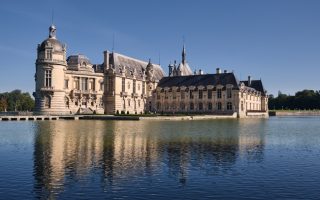Hidden History: Explore Aisne in Picardy
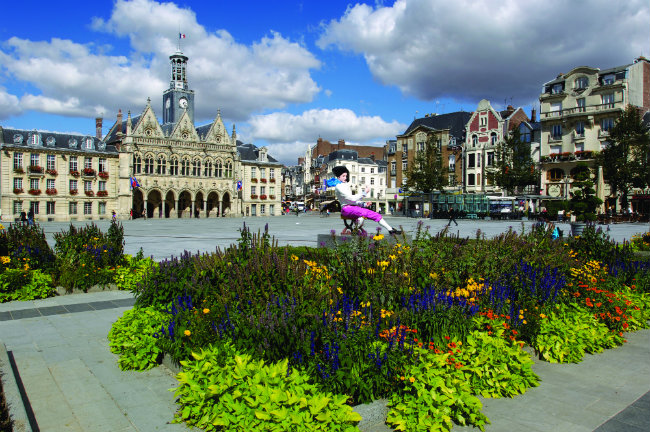
Turning my car uphill towards the lofty town of Laon, my immediate reaction is to look up. The town stretches along a narrow limestone ridge that curves in a dramatic horseshoe above the rich farmland of eastern Picardy, and the road winds tightly up towards the towering cathedral. So it looks like I’m going to be keeping my eyes heavenwards… or am I?
Half an hour later, I’m standing next to the side wall of an elegant property on top of the ramparts and suddenly I’m looking at mussels – hundreds and hundreds of tiny crustaceans whose shells form part of the local building material. And there’s more to come promises my guide as she unlocks the door to an extraordinary underground world, Les Souterrains de Laon.
This maze of ancient passages is just one surprising subterranean aspect of a department that has more than its fair share of underground tourist attractions. And yet most people passing through Aisne have no idea of their existence.
The most easterly of Picardy’s three departments, Aisne is tucked in the angle between Nord and Champagne-Ardenne, mostly glimpsed by those who whizz down the motorway from Calais to Reims. But turn off the fast lane and you’ll be richly rewarded; the area is ideal for an easy-access short break or a couple of days’ stop-off on the journey home.
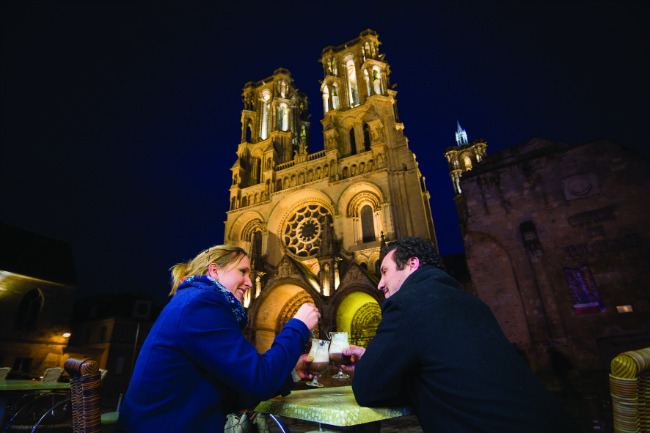
Laon Cathedral is an early example of French Gothic
architecture. Photo: CRT Picardie/ Xavier Renoux
Head south from Calais and the gateway to Aisne is Saint-Quentin, a true phoenix from the ashes. A major logistics hub for German forces from October 1914 to October 1918, this fortress town on the Hindenburg line was 80 per cent destroyed by Allied bombing in September 1918; the fallen of many nations now lie in peaceful cemeteries around the town.
But in the years that followed, visionary architects rebuilt Saint-Quentin as an example of everything that was fresh, new and optimistic. Today the town is one of the Art Deco gems of France, its buildings embellished with geometric patterns and stylised flowers, wrought iron and bay windows.
Must-see sites include the Basilica, with its Louis XIV organ and stained-glass windows, and the imposing Town Hall. Built in late Gothic style, its façade is covered in intricate sculptures of local characters and animals. Bells chime the quarter hours so nobody has an excuse for being late in Saint-Quentin.
Departmental capital Laon lies to the south-east, a town of two halves – or three if you include the underground passages. Around the foot of the steep ridge, some 20,000 people live in contemporary properties with easy access to the station. On the crest of the ridge, a further 7,000 enjoy an extraordinary degree of tranquillity in the historic quarter with a pigeon’s-eye view of the plain below.
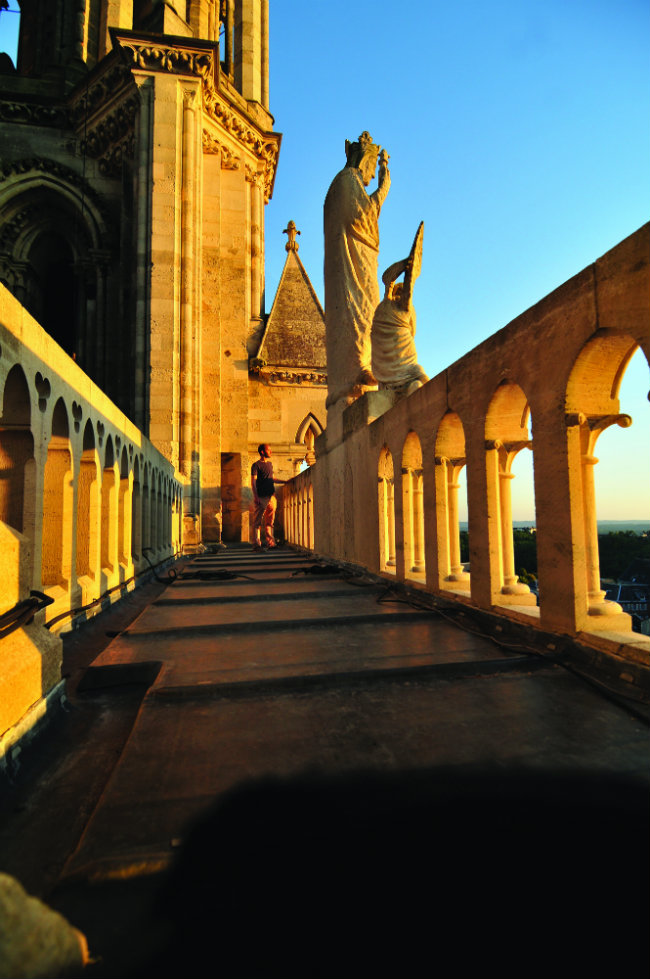
Cathedrale de Laon. Photo: CRT Picardie/ Nicolas Bryant
A Strategic Start
The best place to start any visit is in the atmospheric Tourist Office, which occupies a medieval hospital building next to the cathedral, complete with traces of wall paintings. Don’t miss the model of the 19th-century town, which clearly shows how natural geography gave Laon such a strategic position, not to mention a ready supply of building materials. And do visit the vaulted cellar beneath the Tourist Office, once used to house pilgrims and paupers.
Prosperity came from vineyards, especially in the Middle Ages, and the last Carolingian kings made Laon their capital in the 9th century. Situated on the Via Francigena between Canterbury and Rome, the town established strong links with England, its visitors including the ill-fated Thomas Becket. In 1594, it took Henri IV of France two months to conquer the town, so he then went on to clear two churches and the covered market to make way for a citadel.
Stand in front of Notre-Dame Cathedral today and the flamboyant façade inspires the same sense of wonder as it must have done to medieval pilgrims, though you need to stand back a bit to take in its five towers. There should have been seven, but two were never finished. The interior is much simpler, with most of the original stained glass lost in a catastrophic explosion in 1870, of which more in a moment. For a high-level view, book at the Tourist Office for the guided tour that includes access to the gallery and sculpture collection – daily at 14:30.
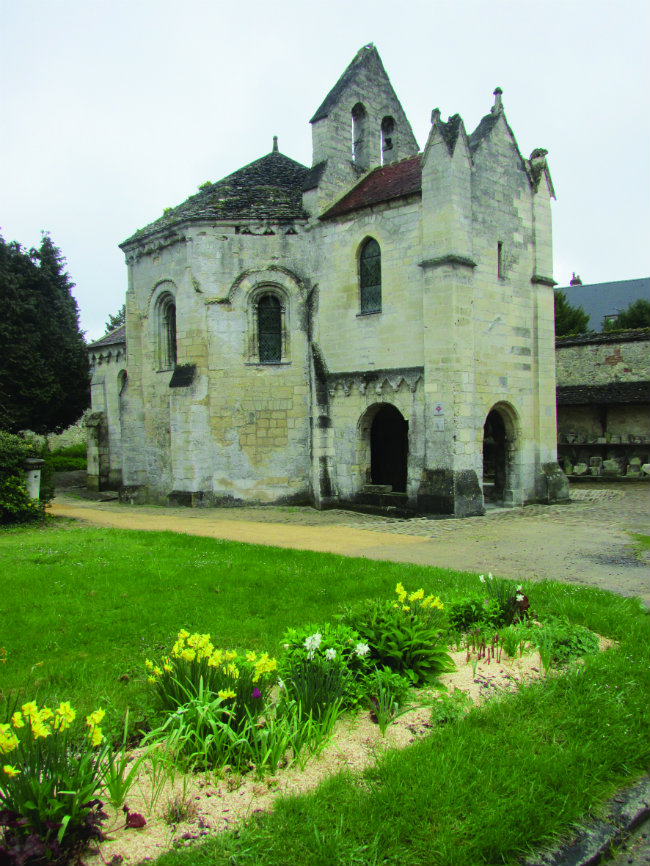
The Templar chapel in Laon
But Laon’s most fascinating tour takes visitors into Les Souterrains, a maze of passages and underground rooms. Quarrying for limestone began in the 5th century and today there are three levels of tunnels beneath the town, the supporting pillars still bearing the marks of the quarrymen’s tools.
The guided tour – 15:30 every day – is a 90-minute insight not only into an underground world but also the town’s hidden history. And we’re talking very ancient history here. We’ve barely begun our tour when our guide points to something like an ice cream cone, 12 inches long, embedded in the floor. And another in the wall. And another. The fossilised forms of sea creatures dating back 40 million years.
We follow roughly-hewn passages and chambers, discover a 12th-century prison, and then fast-forward to the 19th century to explore brick casemates built into the ramparts under King Louis-Philippe. The Prussians invaded in 1870 without firing a shot, but a guardsman blew up the powder room, killing hundreds of people and shattering the cathedral windows.
Fortunately much of historic Laon still remains. Visit the chapel and museum of the Knights Templar, walk the quiet streets, and explore the steep paths, or grimpettes, which cut down through the wooded slopes to the lower town.
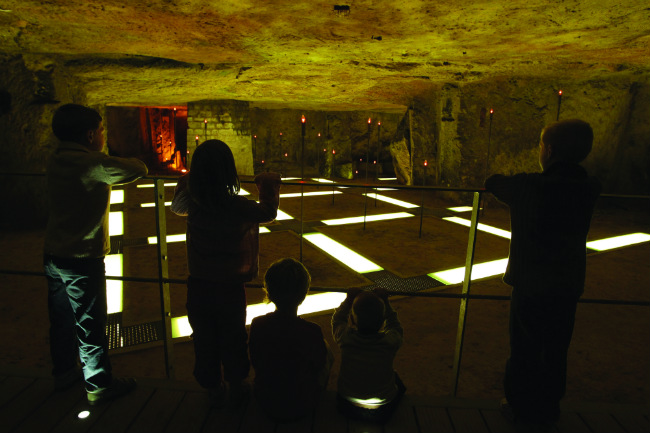
The Caverne du Dragon was a strategic WWI location. ©AS.FLAMENT
To the south of Laon stretches the notorious Chemin des Dames, a roadway along a ridge that runs along the north of the Aisne valley. Legend has it that the owner of a local château wanted the track improved so the daughters of Louis XV could visit her. They never did, but the Chemin des Dames became one of the most notorious names in the history of World War I.
With sweeping views over road, rail and river, and – you guessed it – with quarry tunnels inside for sheltering men, the ridge was strategically prized by both French and German troops. Between April 16 and 25 in 1917, nearly 100,000 men were killed or wounded on the French side alone. Many subsequently mutinied and 49 were shot by firing squad as an example.
Today, the platform outside the Caverne du Dragon, as the tunnels became known, offers a panoramic view along the ridge and over tranquil farmland. Yet every autumn ploughs turn up around 20 shells and 100 grenades, a figure that is expected to stay constant for centuries to come.
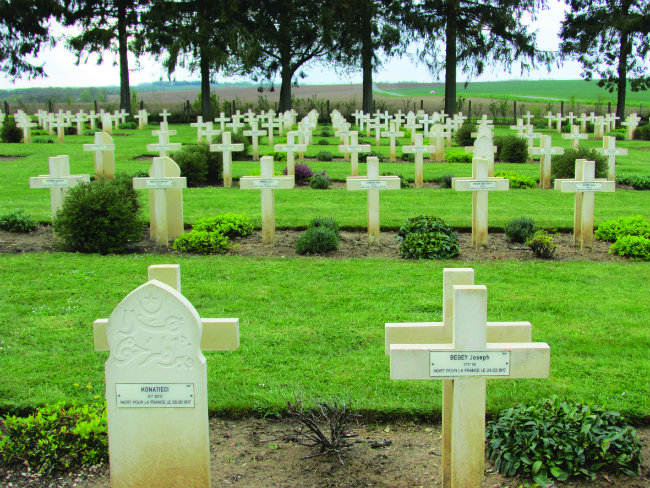
Cemetery for the French fallen in Cerny-en-Loannois
Hidden History
Head inside the hill and you immediately understand why men were tempted to rebel as you tour dimly-lit chambers dotted with rusting weapons and displays of handicrafts made from shells and bullets. It’s shocking, moving, but despite all that, it’s a must-see: Europe’s recent past brought vividly to life. Then head out into the sunshine to visit the other historical sites of the Chemin des Dames (see below for more information).
Jollier by far was my last underground visit in Aisne, the well-organised, well-stocked cellars of Pannier Champagne in Château-Thierry on the Route de Champagne. The stone quarries here on the edge of the Marne Valley vineyards date from the 12th century, and some ancient stone cutter once carved a tiny archer into the wall of these deep galleries. Discovered in 1990 by archaeologists, he’s now the symbol of this prestigious brand.
Pannier Champagne is the champagne chosen by Air France and one of several – a tactful decision – served at Presidential receptions. So take the tour, enjoy the tasting and, for a few minutes at least, get your own personal taste of the high life.
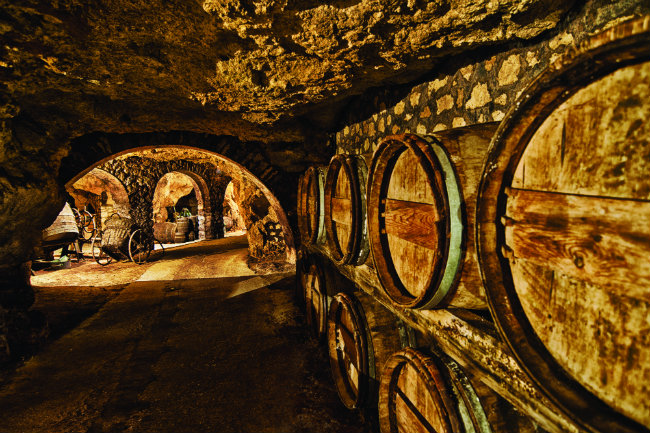
These 12th-century stone quarries serve as cellars for
Champagne Pannier.
Travel Tips/Essentials
Explore the Chemin des Dames
A short circular drive from the Caverne du Dragon links a number key sites on the Chemin des Dames. Enjoy a picnic or lakeside stroll amongst the atmospheric ruins of Vauclair Abbey, founded in 1134 by the Cistercians and virtually destroyed in 1917.
A statue of Napoleon marks his victory against the Russians and Prussians at Craonne in March 1814, but deeply moving is the buried village of Vieux Craonne which was annihilated a century later. A new village was built nearby and today grassy mounds and trees cover the spots where houses and public buildings once stood, their position marked by archive photos and information boards. One particularly poignant picture shows villagers celebrating the centenary of Napoleon’s victory in March 1914.
A 15-minute walk along a marked path links Vieux Craonne with California Ridge, so called for the species of trees brought from America by the château owners, and the strategic Balcony Trench below it, taken by troops from the French Basque country in 1917. A memorial to the fallen shows a Basque man in a beret looking towards his homeland.
For a reflective stop, I’d also recommend the peaceful Commonwealth cemetery of Vendresse and nearby Cerny-en-Laonnois, where French and German soldiers lie in adjacent fields, along with the fallen from many nations. Humbling.
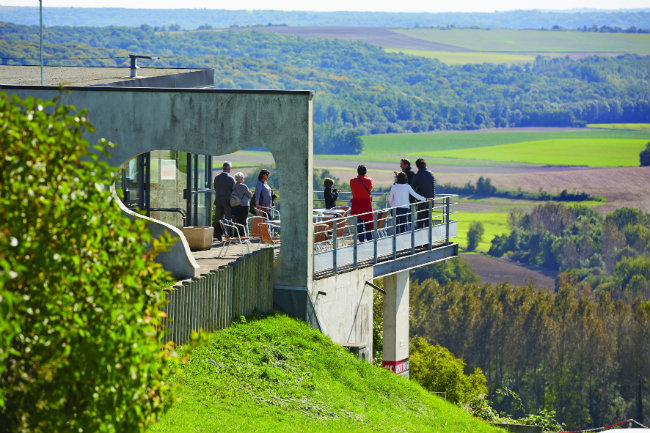
The Caverne du Dragon museum/ Chemin des Dames. Photo: CRT Picardie/ Guillaume Crochez
Family Château
In the very south of the department, to the east of Château-Thierry, the small village of Condé-en-Brie is home to a country house with a big history. The Château de Condé is set in a large wooded park on the Route de Champagne, a classic whitewashed château with slate roof and turrets.
If you know your French history, you’ll enjoy treading in the footsteps of the Princes of Condé, a branch of the Bourbon dynasty, and famous guests such as Jean de La Fontaine, Cardinal Richelieu and Mazarin. Only miles from the Chemin des Dames, the property was occupied by German troops during two World Wars but whilst the interior was seriously damaged, the fabric of the building was untouched.
Today it’s a much-loved family home where visitors take a self-guided tour (with documentation in English) to enjoy 17th- and 18th-century artwork and furnishings, trompe l’oeil paintings, and a wealth of quirky stories about life and intrigues here across the centuries. There’s also a treasure hunt trail for children around the park. Open every afternoon except Monday 2:30-17:30, Easter to November. www.chateaudeconde.fr
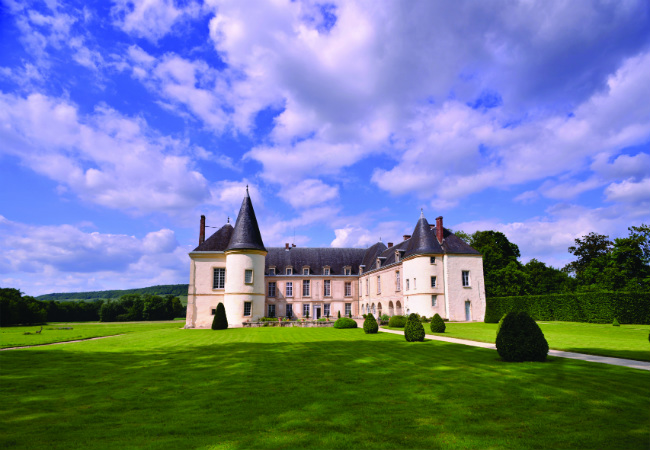
Chateau de Condé-en-Brie. Photo: CRT Picardie/ N Bryant
GETTING THERE
Gillian travelled with Eurotunnel from Folkestone to Calais. www.eurotunnel.com
WHERE TO STAY AND EAT
Close to the Chemin des Dames, the Hôtel du Golf de l’Ailette at Chamouille offers 58 spacious rooms with lake views and tempting seasonal dishes in the Albatros restaurant. www.ailette.fr
On the outskirts of Château-Thierry, the Best Western Hôtel Île de France is well placed for touring the Champagne Route, with a popular gastronomic restaurant. www.hotel-iledefrance.com
The Auberge de Condé-en-Brie occupies the old SNCF station beside the château. It has seven cosy rooms, menus with local produce, and a friendly welcome. www.rfc-hotellerie.fr
WHAT TO DO
www.caverne-du-dragon.fr Museum, interpretation centre and tunnel tour.
www.chemindesdames.fr Guide to remembrance sites along the route.
www.champagnepannier.com Cellar tours and on-site shop.
CONTACTS
www.evasion-aisne.com Official site for Aisne with English version.
www.picardietourisme.com Official site for Picardy with English version.
www.saint-quentin-tourisme.fr Online booking facility, French only.
www.tourisme-paysdelaon.com All you need to explore the area, French only.
www.aisne14-18.com WWI remembrance sites and memorials, in French and English.
From France Today magazine
Share to: Facebook Twitter LinkedIn Email
Leave a reply
Your email address will not be published. Required fields are marked *


